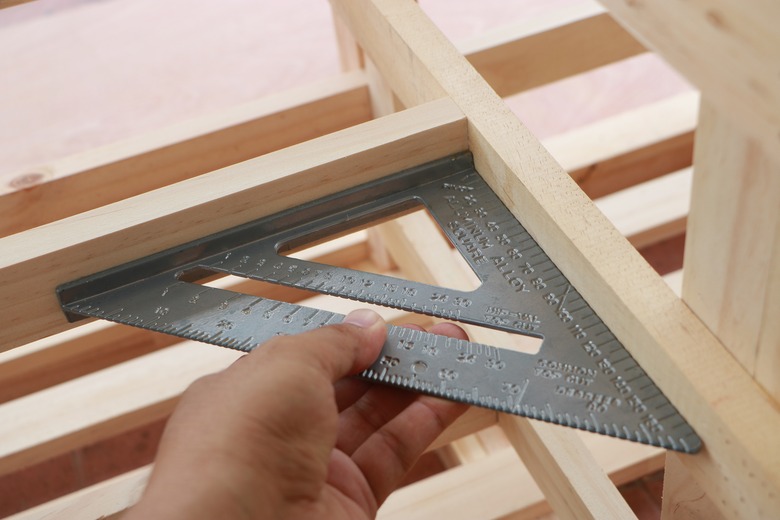How To Calculate A 90-Degree Angle
The 90-degree angle, also known as a right angle, is one of the most prevalent angles used in architecture. The 90-degree angle, formed by two lines that are perpendicular to each other, is a basic geometric concept. Geometric shapes such as squares and rectangles use right angles exclusively. There are a number of ways to create a 90-degree angle or determine whether an angle is 90 degrees, depending on the application, the tools and information at hand.
Step 1
Measure the angle with a protractor if possible. If the angle in question is in a diagram or illustration, and you are sure that the drawing is to scale, then measurement with a protractor is a precise and accurate way to determine the degree of the angle. Simply line up the bottom of the protractor with the angle's adjacent side, align the angle's point with the protractor's cross hairs and note the measurement marking that the opposite side indicates.
Step 2
Use mathematical inference to determine the angle. If the angle you are analyzing isn't in a diagram that's drawn to scale, or if the diagram is too small to use a protractor, you can often use basic geometric principles to determine the measure of an angle. If the angle is indicated with a small square rather than a curved line, then the angle is meant to be 90 degrees. If the angle is a part of a shape such as a rectangle or square, then the angle is 90 degrees. If the angle is part of a triangle, add the measures of the other two angles. The three angles of a triangle always total 180 degrees, so if the sum of the other two angles is 90, then it is a right triangle with a 90-degree angle. Similarly, the four angles of a quadrilateral (a shape with four sides) always total 360. So, if adding the other three angles yields 270, then the angle in question is a right angle. There are a number of other geometric theorems and postulates that can be used to infer the measure of an angle.
Step 3
Measure the angle with a special tool. If you are trying to measure the angle of a cut of wood, for example, you can use a T-square or other measuring square. If you are trying to measure the angle of a star or some similar celestial figure, you can use a sextant, angle finder or some similar line-of-sight-based measuring tool. In addition, a spirit level, also known as a bubble level, can be used. If the bubble is in between the two parallel lines, then the level is at a 90-degree angle from horizontal. Conversely, if the level is laid flat or held sideways and adjusted until the bubble is in position, then the level is at a 90-degree angle from vertical.
Step 4
Calculate whether an angle is 90 degrees using the Pythagorean Theorem. This well-known theorem is often phrased as "A squared plus B squared equals C squared," which indicates that the sum of the squares of lengths of the adjacent sides of a right triangle is equal to the square of the length of the hypotenuse side. With a bit of mathematical ability, this formula (a^2 + b^2 = c^2) can be manipulated and used to determine a right angle. Using a ruler, measure the sides of the angle as well as the distance between the angle's open endpoints. If these values plug into the formula correctly, then the angle is a 90-degree angle.
Things Needed
- Protractor
- Ruler
- T-square
- Spirit level
TL;DR (Too Long; Didn't Read)
A basic understanding of geometric theorems and principles will help you to determine unknown angles in technical drawings and other geometric figures.
Cite This Article
MLA
Trubiano, Crispin. "How To Calculate A 90-Degree Angle" sciencing.com, https://www.sciencing.com/calculate-90degree-angle-8275462/. 13 March 2018.
APA
Trubiano, Crispin. (2018, March 13). How To Calculate A 90-Degree Angle. sciencing.com. Retrieved from https://www.sciencing.com/calculate-90degree-angle-8275462/
Chicago
Trubiano, Crispin. How To Calculate A 90-Degree Angle last modified March 24, 2022. https://www.sciencing.com/calculate-90degree-angle-8275462/
